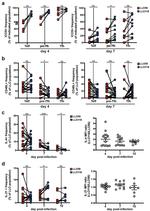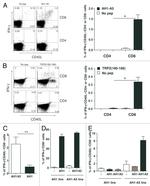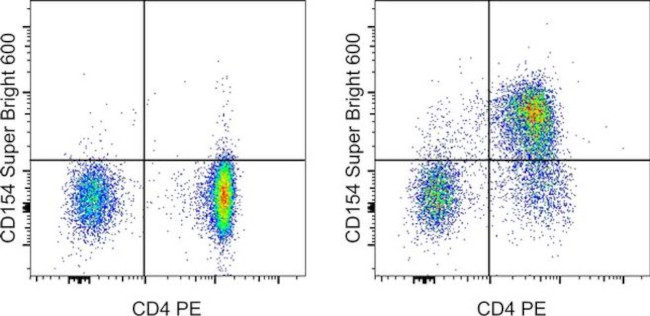Search Thermo Fisher Scientific
Invitrogen
CD154 (CD40 Ligand) Monoclonal Antibody (MR1), Super Bright™ 600, eBioscience™
FIGURE: 1 / 4
CD154 (CD40 Ligand) Antibody (63-1541-82) in Flow




Product Details
63-1541-82
Species Reactivity
Published species
Host/Isotype
Recommended Isotype Control
Class
Type
Clone
Conjugate
Excitation/Emission Max
Form
Concentration
Purification
Storage buffer
Contains
Storage conditions
Shipping conditions
RRID
Product Specific Information
Description: The MR1 monoclonal antibody reacts with mouse CD154, a 39 kDa transmembrane glycoprotein also known as CD40 ligand (CD40L). CD154 is expressed transiently by activated T cells. Through its binding to CD40 on antigen presenting cells (APC) including B cells, monocytes/macrophages, and dendritic cells, it serves a crucial function in T cell-APC cognate interaction. CD154-interaction with CD40 transduces signals for T-dependent B cell activation and induces B cells to enter the cell cycle.
For staining for flow cytometric analysis, it is important to stimulate enriched T cells or enriched CD4 cells (using depletion strategy) prior to staining with MR1.
Applications Reported: This MR1 antibody has been reported for use in flow cytometric analysis.
Applications Tested: This MR1 antibody has been tested by flow cytometric analysis of stimulated mouse splenocytes. This may be used at less than or equal to 1.0 µg per test. A test is defined as the amount (µg) of antibody that will stain a cell sample in a final volume of 100 µL. Cell number should be determined empirically but can range from 10^5 to 10^8 cells/test. It is recommended that the antibody be carefully titrated for optimal performance in the assay of interest.
Super Bright 600 is a tandem dye that can be excited with the violet laser line (405 nm) and emits at 600 nm. We recommend using a 610/20 bandpass filter. Please make sure that your instrument is capable of detecting this fluorochrome.
When using two or more Super Bright dye-conjugated antibodies in a staining panel, it is recommended to use Super Bright Complete Staining Buffer (Product # SB-4401) to minimize any non-specific polymer interactions. Please refer to the datasheet for Super Bright Staining Buffer for more information.
Light sensitivity: This tandem dye is sensitive to photo-induced oxidation. Please protect this vial and stained samples from light.
Fixation: Samples can be stored in IC Fixation Buffer (Product # 00-8222) (100 µL of cell sample + 100 µL of IC Fixation Buffer) or 1-step Fix/Lyse Solution (Product # 00-5333) for up to 3 days in the dark at 4°C with minimal impact on brightness and FRET efficiency/compensation. Some generalizations regarding fluorophore performance after fixation can be made, but clone specific performance should be determined empirically.
Excitation: 405 nm; Emission: 600 nm; Laser: Violet Laser
Super Bright Polymer Dyes are sold under license from Becton, Dickinson and Company.
Target Information
CD40 Ligand (CD40-L), or CD154, is a membrane glycoprotein and differentiation antigen expressed on the surface of T cells. The CD40 Ligand stimulates B cell proliferation and secretion of all immunoglobulin isotypes in the presence of cytokines. CD40 Ligand has been shown to induce cytokine production and tumoricidal activity in peripheral blood monocytes. It also co-stimulates proliferation of activated T cells and this is accompanied by the production of IFN-gamma, TNF-alpha, and IL-2.
For Research Use Only. Not for use in diagnostic procedures. Not for resale without express authorization.
How to use the Panel Builder
Watch the video to learn how to use the Invitrogen Flow Cytometry Panel Builder to build your next flow cytometry panel in 5 easy steps.
Bioinformatics
Protein Aliases: CD154; CD40 ligand; CD40-L; H-CD-40-L; M-CD-40-L; RP23-153G22.3; T-cell antigen Gp39; TNF-related activation protein; TRAP; Tumor necrosis factor ligand superfamily member 5
Gene Aliases: CD154; CD40-L; Cd40l; Cd40lg; gp39; HIGM1; IGM; IMD3; Ly-62; Ly62; T-BAM; Tnfsf5; TRAP
UniProt ID: (Mouse) P27548
Entrez Gene ID: (Mouse) 21947

Performance Guarantee
If an Invitrogen™ antibody doesn't perform as described on our website or datasheet,we'll replace the product at no cost to you, or provide you with a credit for a future purchase.*
Learn more
We're here to help
Get expert recommendations for common problems or connect directly with an on staff expert for technical assistance related to applications, equipment and general product use.
Contact tech support

